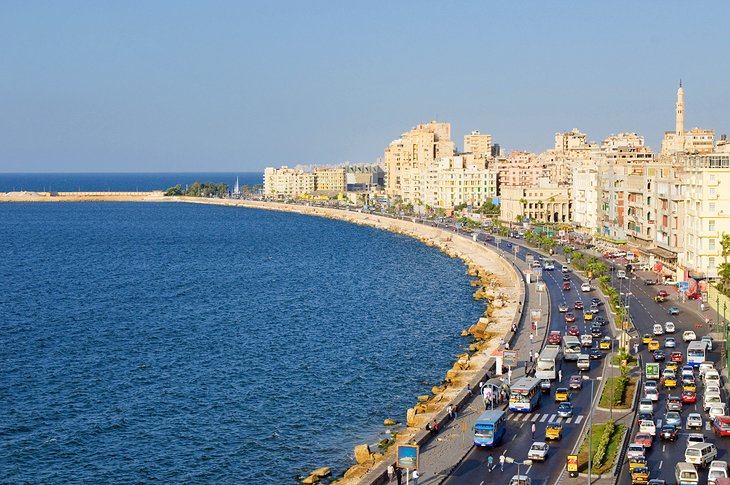Citadel of Qai't Bay : From the lighthouse times till today
 |
| The Citadel of Qai't Bay |
During December 2019, I made my first international trip outside of Asia, to Egypt (something my dad humorously disagrees with). This is going to be my third post about the trip. During my 12 days long stay in Egypt, we made a one day round trip from Cairo to Alexandria. The name of the city should sound familiar. That is because this ancient city was founded by Alexander the Great when he was on a mission to expand his kingdom beyond Macedonian borders. He wanted to be the ruler of the entire Earth, or at least what was known of Earth to the Greeks. Eventually, the city became the capital for the Ptolemaic dynasty and remained a capital city even under Roman and Byzantine Empires.
 |
| The crescent leading to the fort. Source - google images |
Now that we are somewhat familiar with the city of Alexandria, let's move a little forward in time and jump to the medieval times. In 1477 AD, Sultan Al-Ashraf Sayf al-Din Qai't Bay established the Citadel/ Fort of Qaitbay in Pharos Island in Alexandria as a defensive structure against the Ottoman attacks. What used to be an island, is now well connected through road. When you are moving towards the citadel, the road forms a crescent, bordering the sea when seen from the sky. I was reminded of the Queen's Necklace or Marine Drive in the city of Mumbai. Qai't Bay belonged to the Burji Mamluk Sultanate of Egypt and was the 18th Mamluk from the dynasty to become a Sultan. Mamluk was a term that meant 'owned slave'. We have to bear in mind, however, that the Mamluk dynasty of the Sultans of Delhi and that of Alexandria are not connected in any manner. In fact, the concept of buying slaves and later freeing them was a common practice.
 |
| Atop the fort |
The citadel was constructed on the exact site where the lighthouse of Alexandria, an ancient structure dating back to the reign of Ptolemy II Philadelphus (280-247 BC), once stood. It was listed as one of the seven wonders of the ancient world and for many centuries it remained one of the tallest man-made structures in the world. The lighthouse was called Pharos of Alexandria, which in fact gives the name to the island on which the fort is situated. This was not just any common structure but was, in fact, a symbol of the city and civilization. This is attested by the discovery of coins from different centuries which have the image of the lighthouse on one side. The building also finds mentions in the writings of travelers such as Al-Masudi from the 10th century.
This magnificent structure was meant to guide and protect sea travellers, traders, and sailors. However, it could not stand against the test of time. The lighthouse was partially cracked and damaged by multiple earthquakes in the years 796 and 951, followed by a structural collapse in the earthquake of 956, and then again in 1303 and 1323. It is believed when Qai't Bay set out the architectural plans for his fort, some part of the lighthouse was still standing. The fort was then constructed on the platform on which the lighthouse stood and even used some of the ruins of the fallen monument. However, in 1994 this structure was given a new life with the discovery of the physical remains of the lighthouse on the floor of Alexandria's Eastern Harbour by the archaeologist Jean-Yves Empereur. He mapped the location of hundreds of huge masonry blocks; at least some of these blocks are believed to have fallen into the sea when the lighthouse was destroyed by an earthquake in the 1300s.
 |
| Side view |
The Ottomans could have chosen to destroy the fort as a symbol of their victory. Instead, they made the fortifications stronger. A good reason why the fort wasn't destroyed was because of its strategic location which would have proved useful to even the Ottomans to ward off future threats. The fort has been witness to the invasion led by Napoleon Bonaparte, after the French Revolution in 1798. It is believed he landed with around 50000 men and seized Alexandria. Napolean found Qaitbay Fort in a bad state of disrepair and immediately ordered for its restoration. Under the reign of Mohammad Ali Pasha, the fort again underwent restoration. But it was heavily damaged again at the time of Orabi's revolt in 1882.
 |
| View from a restaurant |
It was used as a defensive fortress until the late 19th century when the British bombarded Alexandria. Our tour guide informed us of a possibility of the existence of a mosque inside the fort structure, because of the ambiguity of one spacial area inside the premises of the fort. The view from the top of the fort was absolutely postcard-worthy. Too bad though, that none of the hawkers near the fort were selling postcards. However, the scenic beauty of the fort paled in comparison to the grandeur and the size that many forts in the Indian subcontinent boast of. I was probably comparing the exquisite histories of two regions in an unfair manner. But something was amiss. That doesn't mean that the fort didn't have its own story to tell. If one were to listen carefully, beyond the sounds of the waves crashing against the shore, the bricks would tell us how they bore witness to some of the greatest moments in the history of Alexandria.
Disclaimer - All pictures are owned by me unless otherwise specified.
 |
| Inside the fort |
 |
| Defensive wall structure |



Very well written, Surabhi. Thanks for enriching my knowledge. Keep it up!
ReplyDelete